AIS
AIS stands for Automatic Identification System, which is
actually a silly name. It's a relatively new technology that helps boats
track other boats that are nearby, without having to rely on anything as error prone,
power-hungry, or difficult to interpret as radar. The range depends on antenna height, but
it's usually 15‑50 miles - pretty good for only about 2 watts of power.
For this installment we've included the following sections:
AIS in Action:
Crossing the busy shipping channel just NE of Singapore
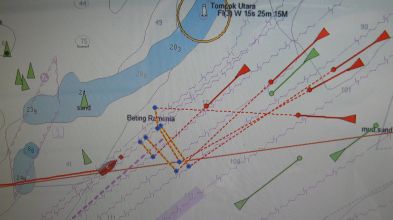
We're the red boat in the lower left, heading NE
Red triangles are ships with a CPA of less than 1 nm
Their solid red pointers are where they'll be in 5 minutes
Yellow lines are their Closest Point of Approach to us |
What is AIS?:
AIS is a navigational aid - probably the best thing since GPS.
Since 2004, all ships over 300 tons and all commercial passenger vessels have been required to carry an AIS
transceiver that broadcasts navigational information (position, course, and speed) for the ship.
The system uses a pair of old VHF channels (87 and 88) that are no longer used for voice
communications. Older AIS units used a full 25 watts, but most newer systems only use 2 watts,
which is still perfectly adequate for 20‑30 miles over open water.
With an AIS system, the ship broadcasts its latitude, longitude, speed, and
direction of travel every 2‑10 seconds, depending on their speed. This information comes
directly from a dedicated GPS on the ship. About every 6 minutes it also broadcasts its
name, radio call-sign, MMSI number, the location of its GPS antenna relative to the rest of
the ship, and various other bits of information. Since a ship's AIS antenna is usually
very high off the water, their AIS signals can usually be picked up many miles away.
We typically pick up ships at 20‑30 miles(!), much further than our radar or our eyes
can see. For more on the AIS system, you might want to look up
AIS on Wikipedia.
What boats do not carry AIS:
Small boats (under 300 tons) are not required to carry AIS
and usually don't, so cruisers must still keep a sharp lookout at all times, especially for fishing
boats. Tug‑boats often don't carry AIS - a serious omission in our opinion, as they
often have restricted maneuverability and/or distant tows which can be very dangerous, especially
at night. Military ships generally turn off their AIS transmitters (which they're
allowed to do) as they usually don't want to advertise their presence or location. But they
usually keep a very good watch so we can count on them to keep out of our way.

Hazy but confusing - Lots of ships outside at the time |
AIS transceiver types:
AIS transceivers come in 2 flavors, class A and class B. Big ships carry class A
transceivers, but most cruising boats are only allowed to carry class B
transceivers . We've heard rumors that ships can filter out class B transmissions, but merchant seamen
say they can't and they probably wouldn't if they could. In fact, they're
very concerned with everyone's safety on the water.
Class B AIS was specified somewhat after class A, and it broadcasts somewhat different
information in a somewhat different format. All class A units can receive class B positional
information, but some older class A units can't receive the additional information (boat name, MMSI,
boat type, etc) from class B transceivers. This is not usually a problem, as it's usually us
little guys who want to contact the big guys, not the other way around.
The joys of AIS:
To work effectively, the AIS system on your boat must also be connected to a GPS, usually through a
chart plotter or a computer. AIS transceivers are required to have their own GPS, but receiver
only units just forward their received information via a serial or NMEA cable. This way,
the navigation display system (usually a GPS connected to a computer or a chart plotter) knows your location,
course, and speed. When it receives a ship's AIS information, it can then project both
your course and the ships course, and from that work out the Closest Point of
Approach (CPA) of the two vessels, as well as the Time to that CPA (TCPA).
This is extremely useful information when you've got a ship bearing down on you, especially
at night. Most chart-plotters are now capable of receiving and displaying AIS data.
Most newer navigational packages including OpenCPN
and MaxSea (versions 10 and above) can also process and display AIS data, and
OpenCPN has a nifty set of
programmable AIS alarms.
AIS in Action:
Crossing the busy shipping channel just NE of Singapore
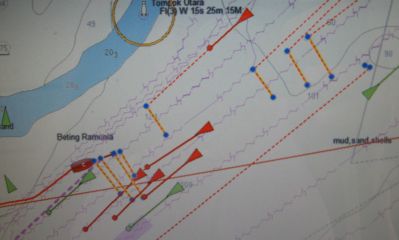
Now we're turning behind the 6 ships coming at us
All these photos are using OpenCPN to display the AIS data |
The real joy of AIS is computing the CPA, so you know how close the ship will
come to you, and also getting the ship's name. So instead of having to
call "Southbound ship at approximate position blah blah" (which ships often
ignore) you can call an approaching ship by name, which they almost always
answer. Since ships also broadcast their MMSI number, you can also use that
to call them directly from your DSC VHF radio. This will cause an alarm on
their bridge which they have to react to. We've found that ships are usually
very willing to alter course slightly to open up their CPA with us.
Antenna height considerations:
VHF is basically line-of-sight communication, so the higher a VHF antenna, the
further it can both hear and be heard. But it's often a pain to
run a second VHF antenna line down from the top of your mast just for the AIS, so many folks simply
mount a second VHF antenna somewhere on their aft‑deck and use that for their AIS. This also
gives some redundancy if the primary VHF antenna should fail, but it limits range. The
height/distance formula for radio (which is a bit different from optical) is:
D=1.42*(√h) or D=√(2h), where D is Distance in miles and h is height in feet above the water.
Ships usually have their AIS antenna up pretty high, probably 100' (30m) above the water.
So the comparison in effective range for a sailboat antenna that's up 10' or 60' is:
| 10': D=1.42*(√100' + √10') = 19 nautical miles |
| 60': D=1.42*(√100' + √60') = 25 nautical miles, an improvement of 6nm or 32% |
So there's a trade-off between effort and range here. When installing a VHF antenna, make sure
to use a good quality coax (RG8 or RG213 or RG8x, but not RG58) if your
cabling run is more than about 30' or 10m.
Antenna Splitters:
Antenna splitters let you use a (single) masthead VHF antenna for both the VHF radio and the AIS.
When one or the other transmits, then the splitter momentarily disconnects the other device.
This prevents the device that's listening (as opposed to transmitting) from being damaged by all
that power going into its delicate receiver section. When neither radio is transmitting, the
splitter lets both share the received signal from the antenna. Since sharing the received
signal this way will halve its power, a good quality splitter will amplify the received signal a bit
to each device.
If you're planning to install an AIS system, I'd advise going with a 2nd antenna mounted
somewhere above the aft-deck instead of an antenna splitter. (Don't simply "T" into your
existing VHF antenna cable! The next time you transmit with your radio,
you'll blow out the sensitive receiver section of your AIS.) VHF antenna splitters quickly disconnect
the AIS as soon as you start transmitting, but they are more than twice the price of a second VHF antenna,
and if something happens to the splitter you lose both your AIS and your VHF radio. Mounting a second
antenna gives you a backup if your primary VHF antenna fails for some reason. You'll get more
range with a masthead antenna, but we've had problems getting antenna splitters to work correctly
with AIS systems.
AIS in Action:
Crossing the busy shipping channel just NE of Singapore
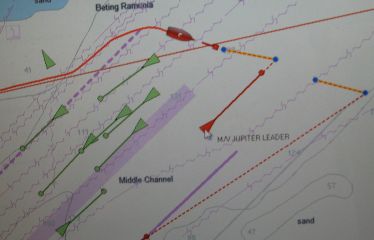
Not a place for the faint of heart
Jupiter Explorer will pass in front of us |
Combined VHF and AIS:
Standard Horizon, our VHF radio manufacturer of choice, is now selling a VHF radio with an
antenna splitter and AIS receiver built into it. This makes all kinds of sense.
The extra AIS equipment more than triples the cost of the radio and the display still seems too
small (although I haven't actually played with one) but I suspect that other VHF
manufacturers will soon follow Standard Horizon's lead and these kinds of units will get better and
better.
AIS Displays:
Some AIS units come with their own dedicated display, and some rely on your chart‑plotter or computer
to display the AIS information. The display units are, of course, much more expensive than
non-display units. But more importantly, AIS has a lot of data to display, and
the dedicated displays have far lower resolution than a good quality chart‑plotter or computer
display. The main advantage that the dedicated display units have is that they draw little
enough power that they can be left on all the time that you're sailing. But for us, we prefer
the non-display units for the cheaper price and better display of using our computer. We don't
leave our computer running all the time, of course, but if we see a ship that we want more
information on, the computer comes on pretty quickly.
Connecting up an AIS:
All AIS units will need to connect to DC power and a VHF antenna (or antenna splitter).
Transceivers will need a GPS antenna connection, while receiver-only units will need to connect to
external GPS information via an NMEA cable. To be effective, most installations will connect
the AIS into their navigational system (computer or chart‑plotter) via NMEA and/or serial cabling.
Note that AIS units generally connect at 34,800 baud, faster than the standard 9600 baud, so you
will have to set your serial port appropriately.
Our AIS depends on an external display (our computer) and sends its AIS
data out over an NMEA‑0182 port. NMEA uses a 0‑5v signaling scheme while an
RS‑232 serial port uses a ±9v signaling scheme, but a good quality RS‑232 serial port can
send and receive NMEA data. Since we also have several other serial and/or NMEA devices
that want to talk to our computers, we
invested in a good quality 4‑port serial to USB adaptor. Ours is made by
KeySpan. Cheaper units are available, but our AIS system was tested with
this KeySpan adaptor. In all the many times I've helped cruisers connect
NMEA devices to their computers, poor quality USB to Serial
converters are by far the biggest headache. Get yourself a good quality
converter and avoid the hassle.
Turning off the AIS transmitter:
If you decide to get an AIS transceiver and you're planning to cross the Indian Ocean (or visit
other areas with known pirate activity) then make sure that your transceiver can turn off the
transmit function when necessary. All class B units that I've seen can do this. This is
perfectly legal, as us yachts are not obliged to carry an AIS transmitter at all. But captured
pirate vessels apparently now have AIS receivers on them, and you don't want them to be able to see
your boat.
Singapore:
Apparently, Singapore may soon be insisting that even recreational vessels be
equipped with an AIS transceiver while they're in Singapore waters. Given the shipping traffic
volumes that Singapore sees, this makes a certain amount of sense (although their own patrol craft
are not currently AIS equipped - they carry a different sort of system). Of course, they can't
do anything if you just bypass Singapore, but apparently boats that stop in any of the Singapore
marinas are being required to rent an AIS or similar device.
AIS Repeaters:
When we were in Malacca, our AIS could see over 1,000 ships between Port Kelang and Singapore, a
distance of some 200 miles. That works out to more than 5 ships every
mile, or one every 1,200' (350m) and many ships are longer than that. Many of those ships were
anchored, but many were also doing more than 20 knots. Since 100 miles is well beyond normal
VHF range, we assume that there are shore-based AIS repeaters along the Malacca Straits, just
as there are in many of the more crowded ports in the USA.
What we use on Ocelot:
We've carried an AIS receiver since late 2006 and we consider it an extremely useful part of our
navigational equipment. Ours ties in with our navigational charting
system (OpenCPN) and draws
only 1.5 watts of power (about 3Ah/day), so we can leave it on all the time.
The receiver is a Chinese built SR161 that we bought from
Milltech Marine in
Seattle for only $189.
Milltech Marine is a
great company: small, well informed, very helpful, good products and good prices. Highly
recommended.
In October 2010 we bought and installed a Camino‑101 class B transceiver for $495, again
from Milltech Marine.
The Camino, like all class B AIS units, comes with its own dedicated GPS so we had to mount the antenna and run the extra cable, but that was
relatively easy. It comes with all the cables you need, and even has both an NMEA and a serial
port. The Camino is about 4x the size of our old AIS receiver but it fit into the same space
and used mostly the same connectors. It setup quickly with the included software and connected
to our navigation system with no real difficulties. The software switch to turn off the
transmitter is in the display software, not the setup software, but we don't need to use it very often.
We've been using the Camino‑101 since late 2010 and we've been very happy
with it. It does what it's supposed to do, day in and day out, with no fuss or bother.
It draws less than 2 watts of power (perhaps 3 amp‑hrs/day) so we generally leave it on all the
time.
If you have any questions or comments about AIS, please don't hesitate to
contact us.
Equipment Pages:
Up | Chart Downloads | Making mbTiles | KAP Files | OpenCPN | Turnbuckles | LEDs | Anchors | Sail Drives | Epoxy Work | AIS | Solar Panels | Watermakers | 3G Modems
Cruising Info:
General Cruising Info | Equipment | Pacific Ocean Cruising | Indian Ocean Cruising | Provisioning Food & Fuel | Cruising Recipes
Top Level:
Home |
Destinations |
Cruising Info |
Underwater |
Boat Guests |
Ocelot |
Sue |
Jon |
Amanda |
Chris |
Site Map |
Make a Comment
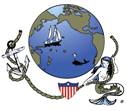 |
Lifetime
Commodores
of the
Seven Seas
Cruising
Association |
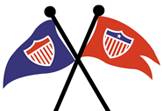 |
|
If our information is useful,
you can help by making a donation
|
Copyright © 2000‑ Contact:
Jon and Sue Hacking -- HackingFamily.com, svOcelot.com.
All rights reserved.





